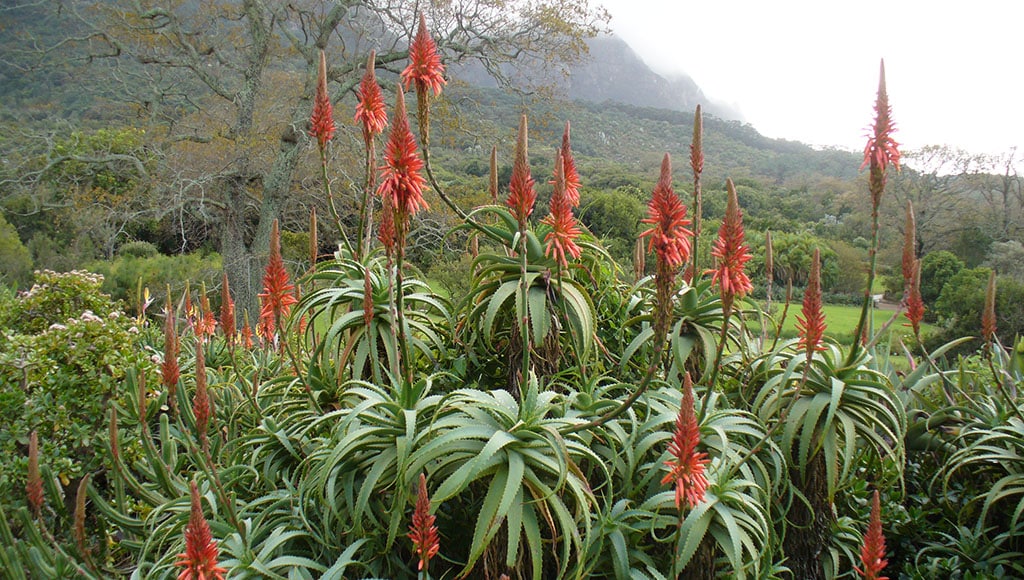At this time of year, and going into January and February, aloes really are impressive. These thorny-leafed succulents whose wonderful flaming spears catch the sun and set the garden alight in winter. Flowers are set off by the architectural curling beauty of their leaves, which, even at the height of summer and without flowers, can fill a garden with interesting shapes, textures, and shadows.
A firm favourite in many Algarve gardens, and especially valuable as they are immune to the dreaded agave weevil. All agaves are from the Americas, and the weevil lives only for plants in the agave family. Planting aloes to replace agaves gives gardeners a whole range of sculptural succulents of all sizes for long-term impact. Once established, they need no irrigation and are adapted to poor soils, but good drainage is essential. Young plants will need some water (every 3 to 4 weeks) during their first summer season to encourage good root growth.

Aloes are, of course, just one variety of succulent which are ideal for our Algarve gardens. Most enjoy the merciless sun of summer, need very little water, grow quite easily in our soils and they seldom look untidy or unhappy. They look good in containers and large planters. Succulents are also useful as fire-resistant planting in areas around our homes and buildings. Aloes associate well with mixed succulent planting.
Aloe distribution covers southern Africa, the mountains of tropical Africa, various islands off the coast of Africa including Sardinia, Madagascar, and as far as the Arabian Peninsula. Aloes respond particularly well to arid landscapes and associate beautifully with local materials such as river gravel, natural rocks, and pieces of wood. They are sturdy plants which provide a chilli red to orange and yellow colour range of flowers in winter and can be an impressive backdrop for other succulents or architectural plants.
Aloes are perennial and capable of living for many years, and, once mature, will flower each year. If it is long-term, low-maintenance, drought-tolerant planting you seek, look at aloes for a surprising range of plants – miniature, shrubby and even treelike.
Indeed, the arid parts of South Africa are home to the largest and richest diversity of succulent plants in the world; an astonishing 4,674 plant species show some form of succulence. Nearly 47% of the world’s succulents grow in southern Africa. The Aloe family alone has around 600 species and hybrids.

Aloes are important plants not only for their contribution to our gardens, but they have also provided an enormous storehouse of medicinal, cultural, and cosmetic properties since time immemorial.
The most conspicuous and well-known example being Aloe vera, which, it is thought, originates from the Arabian Peninsula. Its healing properties were well known to many early civilisations throughout the Mediterranean basin and beyond.
Some of the most useful species for the Algarve include:
- Aloe arborescens forms shrubby clumps and is tolerant of a wide range of conditions. Leaf colour varies from a deep blue green to a light yellowish green with stiff but harmless teeth, flowers are ‘candles’ in an inverted cone shape from bright yellow to orange and bright red. It can create an effective living hedge or fence.
- Aloe ferox are stately plants, tall and single stemmed rosettes with distinctly boat-shaped leaves. The flowers are long, even-shaped candles in a range of red shades. The thick juicy leaves are used in the cosmetic and pharmaceutical industries.
- Aloe striata are short, stemless plants with broad soft leaves of a beautiful light blue to sea green colour with a thin pink to red marginal line. The small, bright orange flowers are in dense clusters.

Some keen gardeners in the Algarve were lucky enough to meet, and to visit the garden of, John Lavranos near Loulé. His inspiring expertise and generous plant-sharing habit has ensured that his memory lives on in many local gardens.
He scientifically described almost 300 new species of plants, and a number have been named in his honour. He was one of the four authors of Aloes The Definitive Guide, the book known as the ‘Aloe bible’, published by Kew Royal Botanic Gardens in 2011. If you can find a copy, I recommend it to anyone wishing to immerse themselves in the wonderful world of aloes.
Links:
https://www.facebook.com/groups/planetaloe/
https://www.mediterraneangardensociety.org/107-aloe.html
By Rosie Peddle
|| features@algarveresident.com
289 791 869 | mgapsec@gmail.com
facebook.com/MedGardenersPortugal
www.mgaportugal.org




















